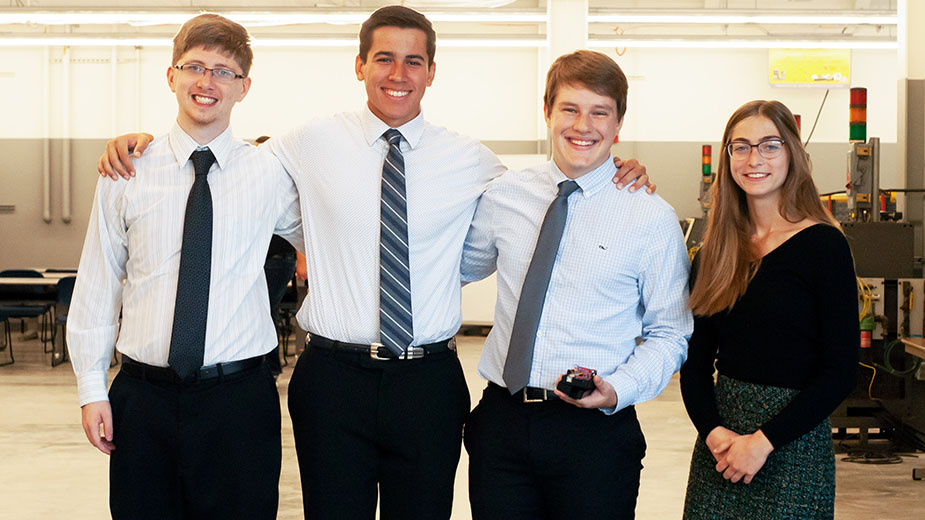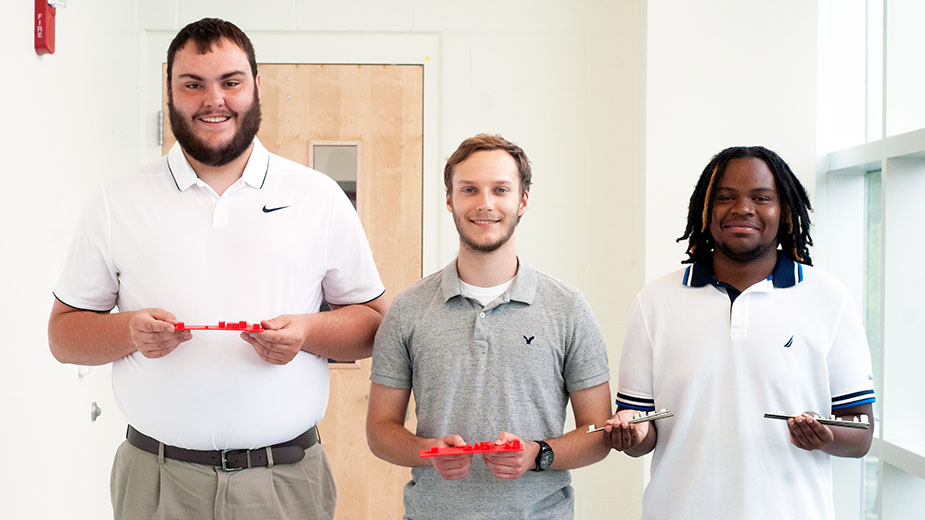YOUNGSTOWN, Ohio – A college program designed to tackle economic decline is working to ensure that Youngstown is no longer another notch in the Rust Belt.
Youngstown State University engineering students had boots on the ground for the last eight weeks to solve problems related to dilapidation, an issue that stems from the fall of the steel industry, according to one student.
“One of the major problems in the city of Youngstown is that in 1977, the steel industry collapsed. There were [about 130,000] residents in Youngstown at the time but that number has dwindled significantly,” says Colin McDonald, a mechanical engineering major.
McDonald is one of seven rising sophomores who are interns in the Community-Engaged Education Ecosystem Model internship program. Two groups worked on projects for eight weeks and presented their findings Aug. 4 to a group of city and school officials, and local business leaders.
McDonald and his group members, Adrian Jones and David Schmidt, came up with an algorithm to streamline city code enforcement and the revitalization of Mahoning Avenue and similar corridors.
“We decided to create a MATLAB algorithm that would suggest whether or not a building or property should be demolished or renovated,” McDonald says.
MATLAB is a programming and numeric computing platform used to analyze data, develop algorithms and create models.
The group worked with city code enforcement superintendent Mike Durkin and the Economic Action Group, a collaborator of the program along with the YSU engineering department, to create an algorithm based on building characteristics and code violations. According to their data, 836 vacant homes qualify for demolition.
The project also presented the three mechanical students with the challenge of developing code.
“We’re not too technologically savvy with algorithms and computer code but it was a fun challenge for us,” Schmidt says. “As mechanical engineers, we like to be dealing with our hands. Being able to write code definitely expanded our vision on engineering.”
Schmidt says the algorithm is composed of questions that are answered on a scale of one to five. Based on the answers, it gives a suggestion of whether the building can be salvaged and renovated or if it should be demolished. Only two factors can override the findings – the safety of a building and whether it’s a green space.
McDonald and Schmidt grew up in the area, making the project a personal investment. It showed Schmidt a different side of the city compared to the suburbs.
“This is our community; we need to give back to the community since we were raised in the community,” he says. “Being able to see the west side of Youngstown really opened my eyes. It gives me a better idea of how the area looked and how it’s been transformed after the collapse of the steel industry.”
The next challenge addressed an issue all commuters to and from Youngstown are familiar with — chuckholes.
Kyle Wareham, Zach D’Antonio, Luke Franks and Gianna Lattanzio worked together to create the SIMUN [Street Information Mapping Unit].
The Economic Action Group gave the groups a list of potential projects that addressed problems within the city. The group chose the project because three out of the four members are commuters to YSU and share frustration with the road conditions.
“We all commuted last year for school and had to drive on these roads every day. We saw there was an opportunity to try and help maintain some of the roads and fix them,” Franks says. “It’s something [where] we can tangibly see ourselves having an impact.”

The device was developed with the intention of helping the city’s street department.
In layman’s terms, the device attaches to the suspension of the car and is powered by a cord connected to the cigarette lighter. When the car hits a bump, the SIMUN moves with it and records data of where it happened.
The group’s objective is for the city of Youngstown to use the device on its own fleet of vehicles—snowplows, garbage trucks, etc. SIMUN would allow the city to collect its own tangible data while performing normal operations, saving it money and time.
“We’re able to take this data and put it into Excel and create this nice heat map that’s easy to read. So, you can visualize all the bad roads and all the good roads in your community,” Franks says, adding that the city can then pinpoint what streets need to be worked on.
Franks is a Pennsylvania native and the project, he says, allowed him to get to know the city from an engineering perspective rather than as a student. Hazel Marie, distinguished professor of mechanical engineering at YSU and principal investigator of the program, says the program aims to reach students like Franks.
“Part of this project is to tie them to Youngstown. A lot of students come here … and don’t know all of the beauty of the Youngstown city that our university is part of,” Marie says. “That’s where we got the community engagement idea. Hopefully this will strengthen their ties to this area.”
Community-engaged education is learning that takes place in and with communities. The Community-Engaged Education Ecosystem Model internship program aims to bring people from different backgrounds and different sectors – educational institutions, local government, and community organizations – together to tackle challenging problems. The program started in 2015 at the University of Notre Dame in South Bend, Ind. – another so-called Rust Belt city.
“Notre Dame has been doing this for nearly a decade. It is in a Rust Belt, Midwest town. It was looking to scale that among other peer cities to see if its model scaled well at the same pace,” says EAG executive director Nick Chretien.
YSU received a four-year grant from the National Science Foundation to fund the program, Chretien says. This is the first year and the projects will gradually expand as the program progresses. The hope is to use student talent to solve city issues.
“It’s to look at things in a new way. It’s to use student talent and to show young minds the Valley and hopefully keep them in the Valley long term by addressing these problems using new skill sets and new ideas that maybe we haven’t in the past,” Chretien says.
Students Franks and Schmidt both plan to stick around the Valley after graduation. They agree that the program opened their eyes to local career opportunities. Schmidt says he has always wanted to stay in the area and the program reinforced that idea.
“From the start of college, I thought I was going to probably stick around because that’s what I want to do. I feel like growing up here I’m going to stay here. I’m going to give back as much as possible,” he says.
Franks says he is excited by the revitalization of the city. The program exposed him to people who stayed here and are making a difference.
“I like Youngstown and it definitely seems like a good starting point to get my feet on the ground and actually make a difference,” he says. “It seems like the city has nowhere to go but up.”
Pictured at top: Youngstown State University mechanical engineering majors Colin McDonald, David Schmidt and Adrian Jones hold a 3D model of Mahoning Avenue. They created an algorithm to show whether a building should be razed or renovated.
